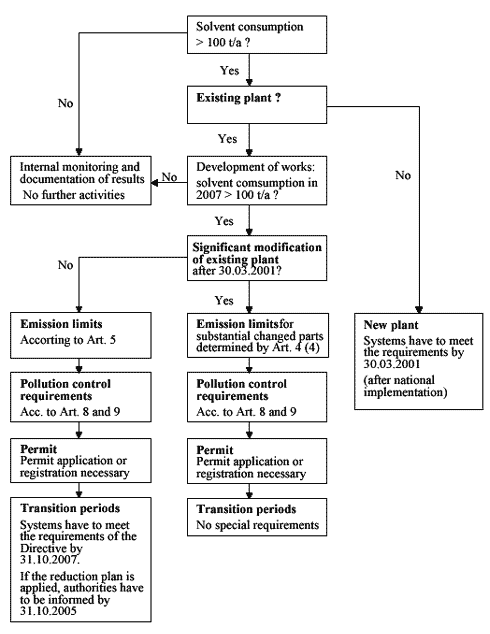VOC Emissions from Manufacturing Processes
2. Environmental Regulation
| 2.1 | National legislation and EC directives |
| 2.2 | VOC limits and threshold values |
| 2.3 | Implementation of the VOC Directive |
2.1 National legislation and EC directives
As noted in the introduction, March 1999 Directive 1999/13/EC of the European Commission was promulgated. This addresses limitation of emissions of volatile organic compounds arising due to certain activities and in specific plants when organic solvents are used.
The VOC Directive will be implemented in national legislation before 30 March 2001.
Danish legislation
Granting of a permit to operate a plant for the manufacture of paints and coatings in Denmark is currently regulated essentially by the following guidelines, laws and ordinances:
| Order regarding approval of listed activities (Bekendtgørelse nr. 807 af 25. oktober 1999 om godkendelse af listevirksomhed)1 | |
| Guidelines for approval of listed activities (Vejledning nr. 3, 1993 om godkendelse af listevirksomhed)2 | |
| DEPA: Industrial Air Pollution Control Guidelines No. 9/1992 (Vejledning nr. 6 1990 om begrænsning af luftforurening fra virksomheder). A revision is planned issued in 2000 | |
| Information from DEPA, no. 15, 1996 C-values - Industrial Air Pollution (B-værdier) |
Subject to their amendment in connection with implementation of Directive 1999/13/EC, these ordinances and guidelines will continue to apply in national legislation.
The VOC Directive
The VOC Directive affects in particular large and medium-sized plants though for a few sectors – like vehicle refinishing – also small-sized plants are covered due to the particular features of these sectors.
For plants emitting certain dangerous substances e.g. chlorinated solvents special limit values apply.
The paint and coatings industry, that is the manufacturers of coating substances, clear varnishes, printing inks and adhesives, is, according to Appendix I of the VOC Directive, affected if they use more than 100 t/a of solvents. These enterprises are now confronted with the challenging tasks of:
| Documenting their solvent situation with a high degree of transparency so as to allow tracking of these substances | |
| Projecting their market situation in 2007 - product range, production volumes - under the aspect of the future solvent balance | |
| Identifying measures needed for compliance with the VOC Directive and evaluating these under their cost aspects | |
| As far as necessary, initiating measures to cut VOC emissions |
2.2 VOC limits and threshold values
According to the Danish legislation the limits and threshold values in Table 2.1 apply.
Table 2.1
Mass flow limits and emission limits for companies that emit organics substances
(Industrial Air Pollution Control Guidelines No. 9/1992). In the air pollution guidelines
a C-value is fixed as a mean hourly value that must not be exceeded by more than about
seven hours a month, i.e. 1% of the time.
Class |
C-value mg/m3 |
Mass flow g/h |
Emission limit mg/normal m3 |
I |
< 0,01 |
100 |
5 |
II |
> 0,01 < 0,2 |
2.000 |
100 |
III |
> 0,2 |
6.250 |
300 |
Additionally, enterprises in the paint and coatings industry as well as manufacturers of
coating materials, clear lacquers, printing inks and adhesives using more than
100 t/a solvent must, according to the new VOC Directive and after the transition
limits stipulated in this have elapsed, comply as a minimum with the threshold values and
limits for solvents as shown in Table 2.2.
Table 2.2
Threshold values and limits for solvents in accordance with Directive 1999/13/EC,
Appendix II A. The regulation means that each company shall fulfil the limits for exhaust
gases and diffuse emissions or the total emission limit (then the limit
for exhaust gases can be exceeded.)
No. |
Activity |
Threshold value |
Emissions limit for exhaust gases |
Limits for diffuse emissions |
Total emission limit |
| 17 | Manufacture of coating materials, clear lacquers, printing inks and adhesives | 100-1,000 >1,000 |
150 150 |
5 3 |
5 3 |
It may be assumed that more stringent limit or threshold values arising from the specific
situation at the site or from any other officially imposed conditions will continue to
apply.
2.3 Implementation of the VOC Directive
Key components of the VOC Directive
Apart from the above threshold and limit values, key components of the VOC Directive are:
| Elaboration of a reduction plan as per Appendix II B, which will allow operators to take other measures to cut emissions by the same amount that would have been attained by application of the emission standards (in this connection, operators can apply any emissions reduction plan) | |
| Compilation of a solvent balance, to serve for the responsible regulatory authorities and the general public as a basis for checking compliance with emissions standards and for determining which reduction options are open |
The key concerns faced by enterprises in the paint and coating industry emanating from the VOC Directive, and the resulting measures, are summarized in Figure 2.1.
Figure 2.1
Decision flowchart for implementing the VOC Directive.

1For plants having a production capacity exceeding 3000 tons per year.
Compiled under the previous regulation.